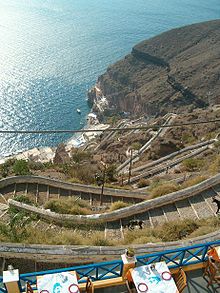Donkey stairs
At a mule ramp (see also equestrian staircase ) is a very shallow staircase that of pack animals can be committed. Originally, donkey stairs were used on steep terrain in open countryside.
Indoor use
The construction principle found its way from road construction into the building architecture . Here donkey stairs denote a spiral, winding or multiple broken staircase in buildings, which has a low gradient and a non-slip floor, divided steplessly or more often at larger intervals by flat transverse beads. This type of staircase occurs in church, castle, fortification and castle towers as well as in all fortress, villa and palace architecture.
The term donkey stairs first appeared in the specialist literature of the 19th century. The name is probably derived from explanations which are intended to justify the designation Eselsturm for the northeast tower of Regensburg Cathedral (11th century). This tower has a stepless spiral staircase. The claim that this was intended for donkeys carrying loads is incorrect. The dimensions are far too small for such a purpose. On the other hand, neither the name donkey staircase nor a similar designation is known for this type of staircase, which was certainly used by carrying and draft animals.
See also
literature
- Roswitha Beyer: Eselstreppe , in: Reallexikon zur Deutschen Kunstgeschichte , Vol. 6, 1968, Col. 21-22
Individual evidence
- ↑ Roswitha Beyer: Eselstreppe , in: Reallexikon zur Deutschen Kunstgeschichte , Vol. 6, 1968, Sp. 21-22

